The International Hahnemann Center Torgau V. (IHZT for short), now based in Meissen, would like to take you back to a time in the late 18th century and the beginning of the 19th century. We would like to accompany you on a journey into the history of homeopathy.
Nowadays, as homeopathy develops in all possible directions, there is an urgent need to preserve the pure and original methodology for current and future students, physicians, practitioners, lay people and patients. In our opinion, it is a necessary task to preserve the early homeopathic knowledge and relevant objects from that time for our highly respected and beloved medicine and to make them available to all mankind. Not only that, we want you to immerse yourself in a time of enlightenment – we want you to feel homeopathy history.
Some readers may have seen our first exhibits in Torgau, where we experienced adverse circumstances.When we were still located in Torgau, the town where Hahnemann wrote the first edition of his Organon of Rational Medicine, we did not have the support of the local officials. In fact, we encountered opposition despite the international homeopathic community trying to satisfy the demands imposed by the mayor and city council. Even then we were rejected.
However, something seems to have changed in Torgau in the last few weeks and a visit to Torgau can also be interesting for homeopaths again. But the events of that time in Torgau also showed us that the history of homeopathy and its value for today’s medicine – for today’s health care system – still needs some clarification. Homeopathy, which is developing in all directions, also needs reflection and an ongoing understanding of the roots of homeopathy.
There is no doubt that our exhibits, which are now in Meissen, Germany have material value but greater is their spiritual value. While material value is owned by owners (who care responsibly), spiritual value is owned by humanity. It’s our story together. The exhibits help us to better understand Hahnemann’s time, the time of the Enlightenment and to immerse ourselves in that time.
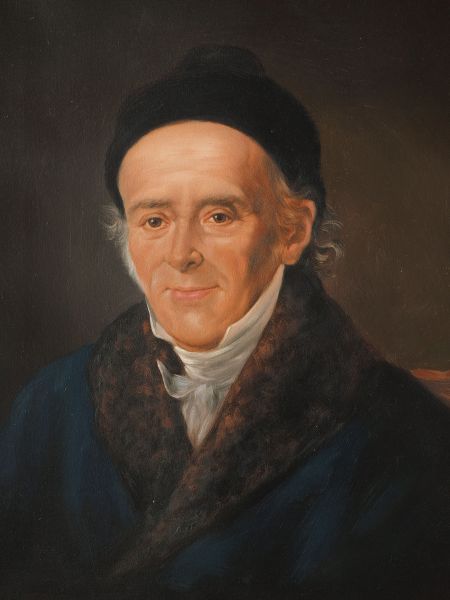
Picture S. Hahnemann (1) © IHZT
We want to go even further: we want to feel the story. For several years now, the IHZT has not only been maintaining and expanding the unique exhibition about the life and work of Samuel Hahnemann and early homeopathy, but we also accompany tourists to all the important places where Hahnemann contributed to the development of medicine and homeopathy – places that are still important for the history of homeopathy and where we can still find evidence of the history of homeopathy. We embark on a journey together with our international guests, open doors, provide touching moments and unique experiences. Sometimes our trip takes us as far as Stuttgart to the Institute for the History of Medicine, which lovingly cares for unique relics, some which it owns, and makes them accessible to the public.
The exhibits are numerous and each has its story. For example, in Stuttgart we find a lock of Hahnemann’s hair. But we don’t always find the time to travel to Stuttgart. While in the past, it was difficult to travel by carriage and horse-drawn carriage, today’s search for clues takes place in a bus, car or train, depending on the number of participants and luggage. Andreas Jung or I, Carola Scheuren, are always happy to take those interested along on the road.
Would you also like to embark on such a journey? Maybe even now, here and now? Then accompany me for a while, sit back comfortably and allow yourself to be transported for the moment to a scientific phase that later came to be called the Age of Enlightenment.
It was a time when chemistry was still in its infancy and medicine was looking for new concepts for understanding illness and healing.
We begin our search at Hahnemannsplatz 1 in Meissen and stand in front of a multi-story house in the style of the late 19th century and see a commemorative plaque. You guessed it, we are standing at the birthplace of Samuel Hahnemann. The portrait bust and commemorative plaque date back to 1855 and were already hanging on the original birthplace. Here at Hahnemannsplatz, our exhibition about Samuel Hahnemann’s life and work will reopen after the completion of extensive renovation work.
However, we are already showing some exhibits during our search for clues that will help us to better understand the story. From the large number of exhibits we can already see how eventful the life of the chemist, pharmacist, doctor, homeopath, translator and author Samuel Hahnemann was. The son of the city of Meissen rightly received honorary citizenship in his hometown of Meissen in 1841.
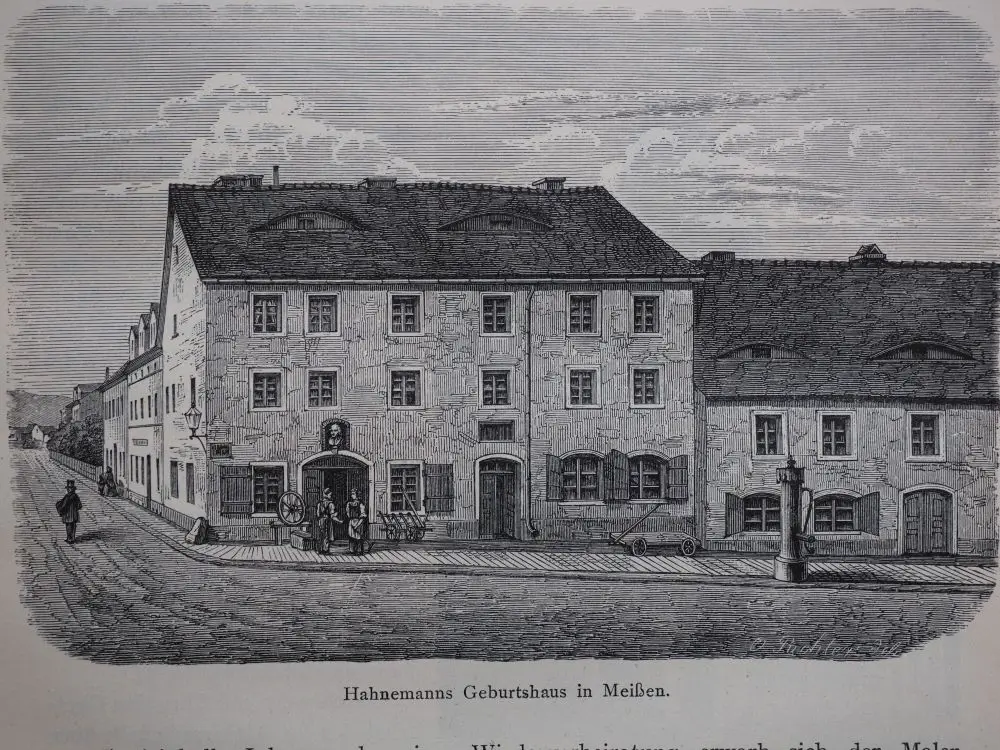
Picture Hahnemann house old and new (2+3)
© Institut der Geschichte der Medizin in Stuttgart/Institute for the Historyof Medicine in Stuttgart
© IHZT (Hahnemann House today)
Let’s imagine we could travel to any year in a time machine. We curiously get in and travel back to the year 1767. Suddenly the place we are standing on is much larger and we look at the house where Samuel Hahnemann was born in Triebischvorstadt in Meissen. Samuel’s father bought the house for 437 thalers in 1753. Later, in 1782, this house was sold through a foreclosure auction due to economic hardship.
It is July 20, 1767 that Samuel leaves this small two-story house and walks over a small bridge and cobblestone street to the nearby town school. It’s his first day of school. He has 4 siblings, 2 are older than him, 2 are younger. His youngest sister Benjamina has just been born. At the age of 12, Samuel was admitted to the city’s Latin school, which had been located in the buildings of the former Franciscan monastery since 1541. Samuel longed for this day for a long time. Samuel is talented and inquisitive. Even while he was still at school, he tutored his classmates in Greek.
Later, Samuel was allowed to follow the Magister Johann August Müller, whom he admired, to the Princely State School St. Afra in Meissen, to which the latter had moved. Müller had given the boy one of the coveted vacancies. Each day Samuel will read the words sapere aude, the school’s motto, above the school’s entrance. Samuel venerated these words, which translates as “Have the courage to use your own mind,” and internalized them in his life. He would later have the words printed in every edition of the Organon.
The library of the state school contained some bibliophilic treasures. A real treasure of writings written in Greek and Latin – masterpieces of antiquity – are available to the teachers and students, which pleases the linguistically gifted Samuel very much. Back in 2023, we also walk the Samuel’s school paths. More than 230 years later, the visitor can still see and touch the weathered original inscription of the school in a back part of today’s school for the gifted.
The monument to Samuel Hahnemann erected in 1957 at the site of his parents’ burial place was then open to the public. The bronze bust is a cast of a bust created in Paris in 1839 by the talented sculptor Franz Woltreck. We are now very close to the Meissen Porcelain Manufactory and if time permits, a visit there will give us a glimpse into the fascinating history of Meissen porcelain.
We also visit the Meißner Hahnemann Center at the former Cistercian convent in Heilig Kreuz. In Hahnemann’s time, the site served as a commercial area for the Prince’s School. It is not known whether Hahnemann worked there or helped with cultivation or harvesting. Today, seminars, congresses and training courses take place here. A large pharmacy garden and a Hahnemann garden invite one to linger.The umbrella organization of Hahnemannstätten Deutschland e.V. was founded here in the MeißnerHahnemannzentrume.V. in September 2021.
Our next stage of travel is Leipzig. Samuel Hahnemann begins his medical studies in Leipzig and, after moving numerous times, will live and work in Leipzig again from 1811. That’s why Leipzig is a “must” even for those who are looking for traces more than 230 years later.
First we visit the Hahnemann monument at Richard Wagner Platz. The monument was ceremonially unveiled on August 10, 1851 during a conference of the Central Homeopathic Association.
On the pedestal it reads:
THE FOUNDER OF HOMEOPATHY SAM. HAHNEMANNGE
B TO MEISSEN D.
APRIL 10, 1755 DEST. AT PARIS D. JULY 2, 1843
FROM HIS GRATEFUL DISCIPLES AND DEVOTEES
Today the Hahnemann monument is a popular place to take a photo. Again and again it is framed by a splendor of flowers adapted to the seasons. I cannot estimate the immense number of photos with this motif that are probably on the desks of homeopaths all over the world today.
In today’s Leipzig we also visit the nearby Pharmacy Museum in the building of the former Central Homeopathic Pharmacy. The entrance is a bit hidden and when you climb the stairs to the first floor, nobody expects such a wonderful and interesting exhibition. The museum presents testimonies from the history of pharmacies and pharmacy in Saxony. Historical pharmacy equipment primarily sheds light on the last 150 years. I like to immerse myself mentally in the time when the central pharmacy was created. The history of Wilhelm Schwabe and the associated history of the German Homeopathic Union, DHU for short, also belong to this place. We delve into the history of homeopathic remedies and the Enlightenment, a landmark legal battle, and a time when supporters of homeopathy multiplied.
We like to linger in front of a display case for a while. We look at a small, inconspicuous booklet about Hahnemann’s habilitation, Helleborus niger and some other exhibits from the history of homeopathy.
We’ve already heard and seen a lot, but let’s travel back together with the time machine to the year 1777 to understand the path that Hahnemann went. The young Hahnemann sits in the lecture hall of the University of Leipzig and has been studying medicine for two years.
At Easter 1775, Samuel Hahnemann was released from St. Afra with his high school diploma. In Leipzig, Samuel earns his living with medical and scientific work. From time to time, he also works as a private tutor. Both enable him to make a modest living. He is not so happy with the theoretical studies. He wants to see patients and help at the bedside. He interrupts his studies in Leipzig and goes to the University of Vienna, where he received bedside instruction from the medical professor and medical director of the Hospital of the Brothers of Mercy, Joseph Freiherr von Quarin.
Soon he ran out of money and took a job in Siebenbügen for 2 years, among other things as a private tutor. With what we know today, we understand Hahnemann’s dissatisfaction. Hahnemann felt that the medicine he was studying at the university was not bringing the necessary success. But it was the lesson of many decades ago – can that be wrong? What is right, what is wrong?
With our time machine we travel to the year 1785. We observe the 30-year-old Hahnemann in Gommern. A few years earlier he was still studying a new science called chemistry. Yes you’ve read correctly. Knowledge of chemistry was still in its infancy. Dr. Hahnemann runs a small medical practice again, but the income is barely enough to support his small family. He is now a husband and father of a 2 year old daughter named Henriette. He sits at his desk and keeps translating medical works to improve his income.
That year, thirty-year-old Samuel Hahnemann published his translation of a book entitled Der Liqueurfabrikant. A few years ago, the International Hahnemann Center Torgau (IHZT) received an offer from a dedicated homeopath. He gave us the opportunity to add the original to our collection at a reasonable price.
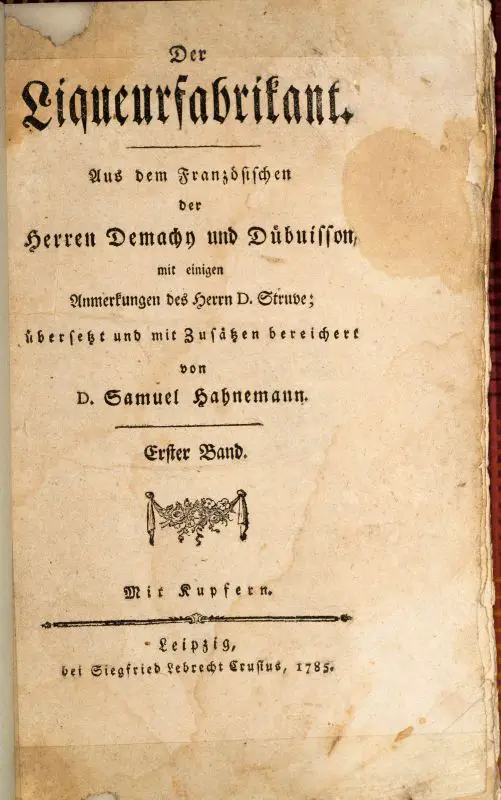
Picture: Liqurfabrikant (4)© IHZT
This book is now 237 years old, almost two and a half centuries! What has happened since then? How many new insights were gained during this time? This book is a witness to a time when one of the brightest scientists of all time shone on planet earth. We are proud and happy to show this book to visitors.
Also in 1785, the town physician, Wagner, made it possible for the then 30-year-old Hahnemann to work in all hospitals in the city of Dresden. So he not only had his practice and worked tirelessly as an author and translator, but also treated patients in the hospitals of Dresden. The beautiful Dresden, with its many sights, is certainly worth a visit today and offers a lot of history, but unfortunately we do not find any traces of Hahnemann in Dresden.
With the extensive exhibits of the IHZT we can always put ourselves back in time, which deepens our view of the beginnings of homeopathy and makes it easier to understand. They help us to search for clues and to put what we have seen in the context of the time. With our knowledge of today, we can comfortably dive into the time of the Enlightenment and accompany and understand Hahnemann’s path to homeopathy. When reading the writings, we go back to the roots, to the source, to the origin – and follow the traces that Hahnemann left us.
In 1787, together with the Brussels pharmacist van den Sande, Hahnemann wrote the book “The Signs of the Goodness and Adulteration of Drugs”, which came from Hahnemann’s pen in the chemical part and in the components of the drugs. Hahnemann specifies the ‘testing materials’ for the medicinal products as aptly and exhaustively as can still be found in modern pharmacopoeias (official pharmacopoeias).
At that time, Hahnemann was already complaining about the “unreliability of the pharmaceutical preparations” and asking: “What should the doctor rely on?” Because every pharmacist mixed the prescriptions differently, the quality of the starting materials was very mixed. How the pharmacist deals with the prescriptions is always a big topic in Hahnemann’s life, even leading to legal disputes in court, as the esteemed reader knows from the history of homeopathy.
Chemists at that time were also looking for a mercury preparation for the treatment of (mostly syphilitic) patients, especially for the treatment of venereal diseases, which could be less caustic and toxic than the usual one. In 1789, Hahnemann found a process for the production of Mercurius solubilis that was much more tolerable. One critic remarked: “Art owes one of the most effective mild Mercurial preparations to the well-known and therefore immortal Hahnemann”.
In 1793 and 1799 the two volumes of his 4-part ‘Apothekerlexikon’ (over 1200 pages) were published. “The material in it is arranged alphabetically and discusses all the subjects that interest the pharmacist in his work. Each chapter shows how familiar Hahnemann is with the work. He often cites new devices that he has invented or improved, and he supports them with numerous illustrations to help understand them. Hahnemann proves his expertise even with seemingly insignificant things, because he was a practical man and knew the problems and difficulties of pharmacists. And so it was not a big step towards a series of Hahnemann’s requirements, which he placed in his encyclopedia, being generally accepted for pharmacy administration.
Hahnemann’s spirit of research and iron-willed diligence made important direct and indirect contributions to improving the medical tools of healing, as they were called at the time. He made a significant contribution to improving the quality and reliability of medicines, one of the foundations of the medical art. Did you know all this?
In order to feed the family, he translated Arabic, Hebrew, Greek, Latin, French and English in the evenings. He traveled through the country and rebelled against the unfortunate circumstances of the medicine of that day. The usual remedies (gold, mercury, sulphur) with the devastating ones. Side effects provoked his inner contradiction.
In 1792, at the age of 37, Hahnemann founded a “convalescent home for about 4 insane people. There should be no punishment, fixation and other disciplinary measures, as well as bloodletting, etc. The therapy consisted of discussions, possibly even homeopathic medication. Unfortunately, there was only one patient, Friedrich Klockenbring, who suffered from a kind of manic-depressive mental illness. Hahnemann’s concern was to stop the nonsensical therapies which he received. Today a small exhibition in Gotha commemorates Hahnemann’s convalescent home. The exhibition addresses the homeopathic layman. Gotha is unfortunately a bit off our usual itinerary, but a visit can be included in the tour if you wish.
You probably know how often Hahnemann moved with his growing family. Unfortunately, in most of the places the family usually only stayed for a short time and in regards to that there is hardly anything to visit today. In December 1804, the Hahnemann family moved into a stately Freihaus in Torgau. Hahnemann’s article on the healing art of experience had just been published. Torgau, a station is important because the Hahnemann family settled there for a while. Dr. Hahnemann opened a practice again in Torgau and in 1810 published the Organon der Rationale Heilkunst. The first edition will be followed by five more editions.
A total of five German editions were published during Hahnemann’s lifetime, each of which had some major revisions. How meticulously he worked on changes, improvements and also deletions as one can see from the many inserts and the small size of his writing that our exhibits in Meissen show. The visitor is always enthusiastic and fascinated when he sees Hahnemann’s delicate and small handwritten notes. Not only what he writes is interesting, but the first thing the viewer notices is the even and accurate typeface.
It was very fortunate for the history of homeopathy that water damage in the 1990s drew the attention of historians to the famous former residents. The wrecking ball that had been ordered was stopped immediately and in the years 2003 to 2006 the house was extensively restored and the electoral free house was supplemented with a modern glass extension. The architect couple Hainz planned and supervised the work on the dilapidated original house with great attention to detail. In 2006, with the support of the Homeopathy College Torgaue.V., the house was ceremonially opened to the public again.
But it is not just the publication of the Organon that connects the homeopath with Torgau. Samuel Hahnemann used the word ‘homeopathic’ for the first time in his article “Pointer to the homeopathic use of medicines in previous practice” published in 1807! In 2016, however, the homeopaths had to leave that location due to a political decision. Today there is a local art association in the house and, apart from the walls of the house and the letters above the entrance, Vorort, unfortunately reminds little of Hahnemann. Perhaps this situation will change in the foreseeable future. Initial conversations have recently been re-established. Let’s see if the political leaders of Torgau will come to their senses and learn to appreciate their former residents again.
As already mentioned, Hahnemann moves from Torgau back to Leipzig and we already know many details from this time, so we drive from Torgau to Köthen. On the way there we make a short detour to Oschatz, the birthplace of Dr. Constantine Hering. As one of Hahnemann’s direct students, Hering made a significant contribution to the spread of this healing method in America. I have never experienced a tour where the traveling trackers did not use the travel time to get excited about topics such as the Bushmaster snake, Lachesis, experiences with homeopathic remedies, the history of homeopathy in America and/or today’s experiences of “Hering’s rule”. These professional exchanges also makes our tours unique as experiences, thoughts, emotions are shared. Language problems vanish into thin air. Questions and answers, moving moments and reports about experiences shorten the journey times. We were stuck in a traffic jam for 1.5 hours, but apart from the driver, nobody really noticed because everyone was talking so deeply.
Arriving in Köthen, Ms. Just, the last former tenant of the house, is standing with her large key in front of the old wooden door of the Hahnemann family’s former home. A small plaque adorns the green house. Hahnemann’s former home now houses a small museum. Anyone who has managed to collect facts on the journey so far might become emotional in the noticeable proximity of Hahnemann here on the threshold of the Hahnemannhaus. Reverent, cautious and moved, the travelers enter the house. Here you are very close to Hahnemann. I’ve been to the Hahnemannhaus many times, but I’m also very touched every time.
In the entrance area, Ms. Just tells us about the time when nobody was really aware of the famous residents who once lived here and when coaches stopped in front of her living room. Incidentally, she slowly opens the door to Hahnemann’s study. Hahnemann’s large, comfortable armchair from his time in Paris is the first thing that catches the visitor’s eye. Ms. Just mysteriously opens large treasure chests full of medicines, which not only give an idea of how meticulous Hahnemann was in his work. No, you can even feel it. Tiny little glass bottles are inscribed with his small handwriting. The visitor may carefully stroke the lid with his hand. It’s very quiet in the room. How often will Hahnemann have opened his medicine boxes? How many times have his hands pulled out a bottle or two? During the tour of the house, Ms. Just tells us which parts of the house are original from his time – objects that Hahnemann touched every day. But I don’t want to give too much away. The many entries in the guest books give an impression of the pride that every traveler feels to have been here. Partly written about gratitude and the closeness to Hahnemann, which one particularly feels in this place.
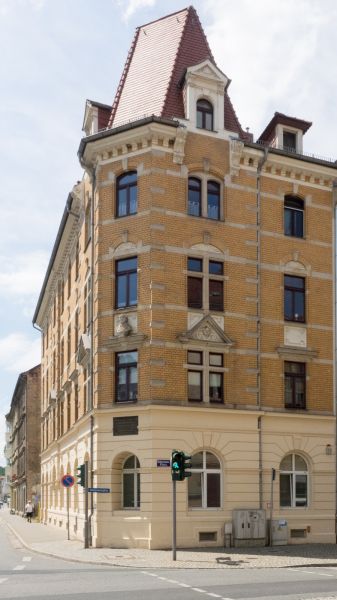
Picture 5
One of the wall paintings in Köthen © IHZTA
The tour of the house and garden quickly takes us back to Hahnemann’s time, now without a time machine. The garden is still the same size as before. How often would Hahnemann have sat there? There is a lot to admire in the house… And you can watch the visitors gently stroking the places described by Ms. Just after the tour. Touch spots that Hahnemann’s hand once touched. The European Library for Homeopathy is located next to the former residential building. The city of Köthen is also honoring its famous son with numerous events.
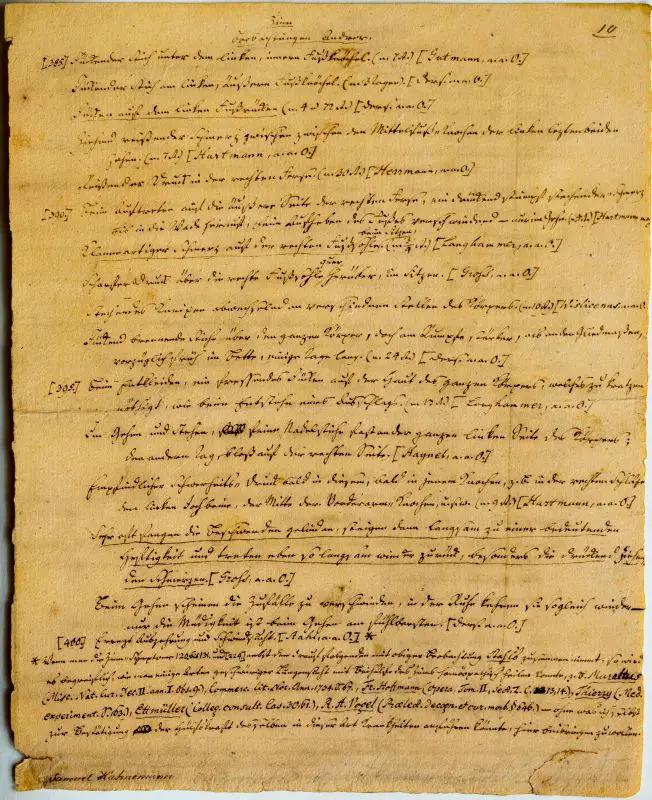
Picture 6
Hahnemann’s Handwriting. 1828 his Entries on tin © IHZTA
A room in the Museum am Schloss is dedicated to homeopathy and it is certainly a touching moment for anyone looking for clues to stand in front of Hahnemann’s deathbed. Of course there are many other interesting exhibits from the history of homeopathy to see in the castle. But it would take too long to list them all. The Hahnemann monument in Köthen and the building of Artur Lutze’s former clinic are also worth a visit. Depending on the season, a tour of the herb garden can also arouse interest.
The many impressions, the many interesting conversations, the many friendships that have developed, the many contacts on the journey – all of this strengthens homeopathy. It makes us happy to be able to make our contribution. It makes me happy to look at the many satisfied faces of the travelers who say goodbye at the end of our little tour, but take a piece of history with them in their hearts. Over a cup of coffee, things seen, heard and felt are highlighted again and there is almost always a lively exchange. The emotion of the visitors can be felt in every word. Reports about Hahnemann’s proximity are repeated again and again – each in his own way. For us, every trip is different, but always an enrichment.
We make wonderful friendships and look forward to seeing the large homeopathic community grow. Would like to see your face amongst this growing now? Does it appear interesting? Is it thoughtful? Do you want to know more? Would you also like to find out everything that hasn’t found a place here? Would you like to touch the relics from Hahnemann’s time and see them with your own eyes? What you will find in our collection or on our tours is part of our common history.
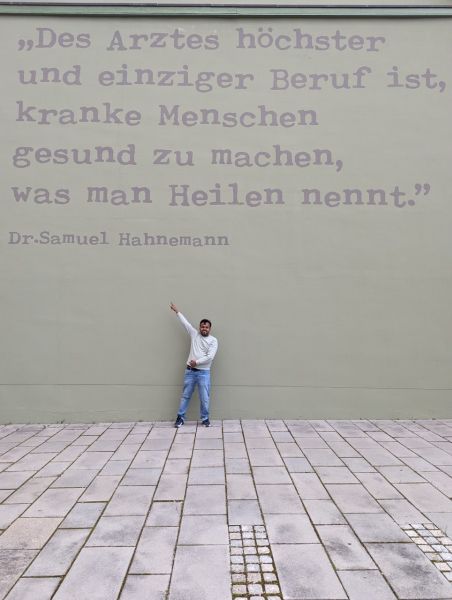
Picture 7 Card
What you experience on our tours is not easy to put into words. Hands-on history is only partially true. They enjoy the privilege of being very close to the Master. You will see and feel what a brilliant mind Samuel Hahnemann had. Who but him could have developed homeopathy? Can you say, I cannot. The written words in the books are the result of a thinking that is beginning to move away from the superstition, conjecture and speculation in medicine and related sciences. This is the beginning of science in the real sense: Hahnemann used unprejudiced, precise observation. He made every effort to verify or falsify his discoveries.
Visit us in Meissen as soon as our exhibition opens, or even better, become a member with us beforehand. Become part of our international community. Help us to make homeopathy history come alive. You can find more information about the tours here:
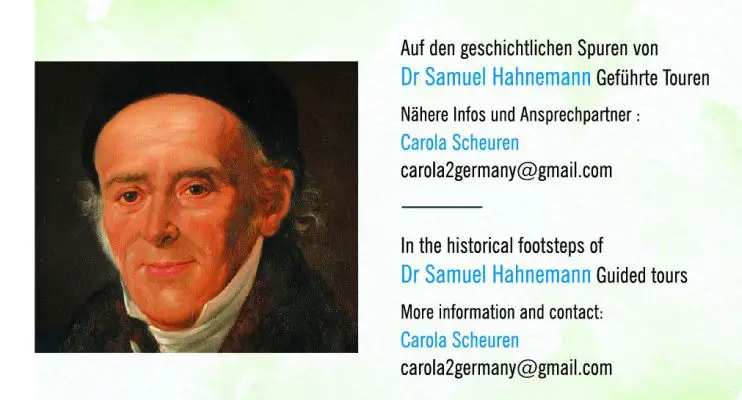
A lifelong dream often comes true on the tours and we create memories that we will all fondly remember.
Original Article by
Carola Scheuren
Chairwoman and founding member of the International Hahnemann Center Torgaue.V.And Board member of the umbrella organization of Hahnemannstätten Deutschlandse.V.
Reference: Hahnemann in Meissen – Helge Landmann




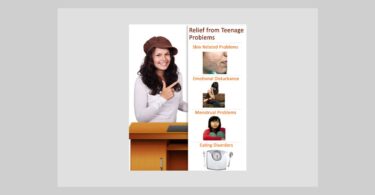
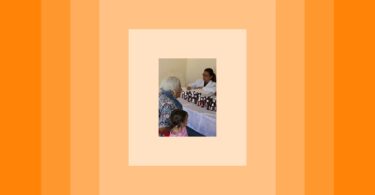
Thanks for article.Many pictures/ photos/ drawings are not visible. May be they are not posted.The texts are fully readable.